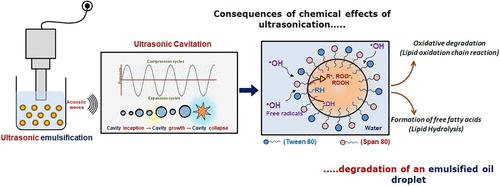水纳米乳中葵花籽油的脂质降解:超声作用及其动力学研究
IF 3.9
3区 工程技术
Q2 ENGINEERING, CHEMICAL
引用次数: 0
摘要
本研究旨在了解超声波对纳米乳氧化稳定性的影响,并评价纳米乳形成过程中油脂通过氧化和水解降解的程度。本文首次通过对纳米乳储存过程中油脂成分变化的分析,给出了超声制备纳米乳中油脂降解的明确证据。在不同的超声条件下(功率和能量),使用不同的乳化剂(Tween 80/Span 80和乳清分离蛋白)制备葵花籽油乳状液。采用logistic方程方法对氧化动力学进行建模,以确定最佳超声参数。结果表明,超过阈值功率和能量密度的过度超声会导致储存过程中过氧化值和脂质氧化率大幅增加。此外,根据纳米乳的过氧化值,改变乳化剂可使脂质氧化降低66%。为了验证乳化油的降解作用,对乳化油储存一个月后的脂肪酸谱进行了分析。结果发现,经Tween 80/Span 80稳定的乳化液经过过度超声处理后,脂肪酸组成发生变化,游离脂肪酸含量增加,证实了氧化降解和水解降解的双重作用。总的来说,研究结果强调了限制超声波能量输入的重要性,并建议使用长链蛋白质乳化剂来提高这种制备的食品级纳米乳液的氧化稳定性和延长保质期。本文章由计算机程序翻译,如有差异,请以英文原文为准。

Lipid Degradation in Sunflower Oil in Water Nanoemulsion: Understanding the Kinetics and Role of Ultrasonication
This study has been undertaken to understand the impact of ultrasonication on the oxidative stability of nanoemulsions and evaluate the extent of degradation of oil via oxidation and hydrolysis during their formation. For the first time, the clear evidence of the oil degradation in ultrasonically prepared nanoemulsions is presented based on the change in the composition analysis over the period of nanoemulsion storage. In this work, the sunflower oil emulsions were prepared at different sonication conditions (power and energy) and using different emulsifiers (Tween 80/Span 80 and whey protein isolate). The oxidative kinetics were modeled by using a logistic equation approach to identify optimal sonication parameters. Results revealed that excessive ultrasonication, beyond a threshold power and energy density, led to a substantial increase in the peroxide value and rate of lipid oxidation during storage. Moreover, changing the emulsifier reduced lipid oxidation by 66% based on the peroxide value of the nanoemulsions. To validate the degradation of oil, the fatty acid profile of emulsified oil after one month of storage was analyzed. It was found that excessive sonication of the emulsion stabilized with Tween 80/Span 80 resulted in changes to the fatty acid composition, including an increase in the free fatty acid content, confirming both oxidative and hydrolytic degradation. Overall, the findings highlight the importance of limiting ultrasonic energy input and suggest the use of long-chain, protein-based emulsifiers to improve the oxidative stability and extend the shelf life of such prepared food-grade nanoemulsions.
求助全文
通过发布文献求助,成功后即可免费获取论文全文。
去求助
来源期刊

Industrial & Engineering Chemistry Research
工程技术-工程:化工
CiteScore
7.40
自引率
7.10%
发文量
1467
审稿时长
2.8 months
期刊介绍:
ndustrial & Engineering Chemistry, with variations in title and format, has been published since 1909 by the American Chemical Society. Industrial & Engineering Chemistry Research is a weekly publication that reports industrial and academic research in the broad fields of applied chemistry and chemical engineering with special focus on fundamentals, processes, and products.
 求助内容:
求助内容: 应助结果提醒方式:
应助结果提醒方式:


